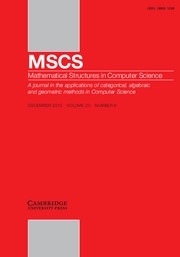Reversible combinatory logic
Published online by Cambridge University Press: 24 July 2006
Abstract
The $\lambda$-calculus is destructive: its main computational mechanism, beta reduction, destroys the redex, which makes replaying the computational steps impossible. Combinatory logic is a variant of the $\lambda$-calculus that maintains irreversibility. Recently, reversible computational models have been studied mainly in the context of quantum computation, as (without measurements) quantum physics is inherently reversible. However, reversibility also fundamentally changes the semantical framework in which classical computation has to be investigated. We describe an implementation of classical combinatory logic in a reversible calculus for which we present an algebraic model based on a generalisation of the notion of a group.
- Type
- Paper
- Information
- Copyright
- 2006 Cambridge University Press
Footnotes
- 11
- Cited by


